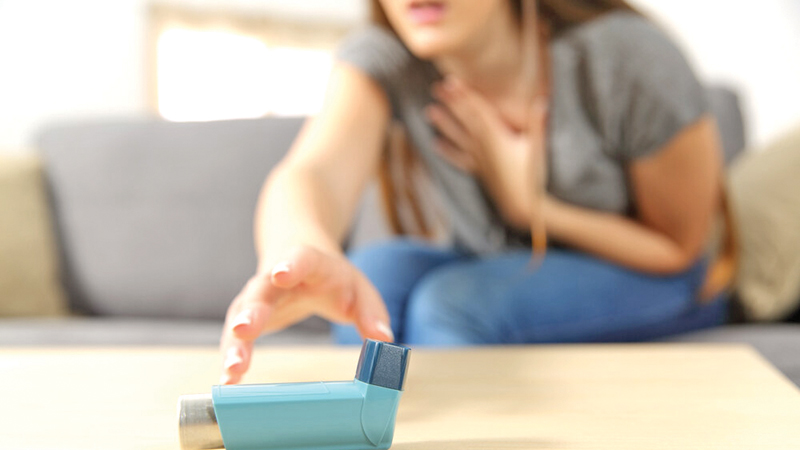 World Asthma Day was observed on May 6. Although asthma is among the most common respiratory diseases affecting people of all ages, recent findings reveal that few are aware of even the basics—until breathing difficulties compel them to seek medical help.
World Asthma Day was observed on May 6. Although asthma is among the most common respiratory diseases affecting people of all ages, recent findings reveal that few are aware of even the basics—until breathing difficulties compel them to seek medical help.
The Sunday Observer spoke to Senior Registrar in Respiratory Medicine, with hands on experience of Asthma management Dr. Chanurdi Wickramathunga, to get a better insight into this condition which could leave long lasting scars mentally and physically on sufferers if not treated early, using available resources found in most hospitals.Additionally, she also gives us some simple tips that any person with asthma can follow at little or no cost.
Excerpts.
Q: The World Asthma Day was on May 6. Many people with asthma breathing problems don’t even know they have this condition until they develop breathing problems. So, tell us what exactly is asthma?
A: Asthma is a chronic inflammatory condition of your airways and occurs when the tubes that transport air to and from your lungs get inflamed and may result in breathing difficulties. You might notice a wheeze, a stubborn cough, your chest feeling tight, or suddenly running out of breath—and these symptoms can pop up or fade away depending on what triggers you. If you leave that inflammation untreated, your airways may scar over time and cause persistent breathing problems.
Q: Do genes play a role? For example, if a person has a family history of asthma are his/her chances greater than a person without a family history of asthma to develop this condition? And why?
A: Absolutely. If asthma, allergies, or eczema run in your family, you might be more likely to have it too. Asthma often runs in families, so if your parents or siblings have asthma or other allergies, your own risk is higher. That’s because you inherit similar traits like how easily your airways get irritated and swollen when exposed to triggers making you more likely to develop asthma yourself.
Q: What are the most common environmental triggers of asthma?
A: Common triggers include dust, pollen, pet hair, mould, and smoke—from cigarettes, cooking, or even incense. You might also notice your symptoms get worse when you have a cold, breathe in cold air, or exercise—especially in chilly weather. Strong smells like perfumes or cleaning products can set it off too. Even stress or certain medications can make your breathing worse. Knowing what tends to trigger your asthma and staying away from those things can really help you keep it under control.
Q: Is asthma risk the same for elders as for the young?

Dr. Chanurdi Wickramathunga
A: In children and young adults, asthma is often linked to allergies and tends to start early in life. Children with asthma usually have a strong family history of allergy-related conditions. In older adults, asthma can either be a lifelong condition continuing from childhood or it can start later in life, which is called late-onset asthma. This form is often underdiagnosed or mistaken for other conditions like COPD. Older people may not have allergies, but things like respiratory infections, medications (like beta-blockers), or occupational exposure can trigger or worsen asthma. Also, aging lungs, weaker muscles, and other health problems can make asthma more serious in elderly patients.
Q: What are the symptoms to watch out for?
A: Keep an eye out for signs that could suggest asthma, such as a persistent cough—especially at night or early in the morning—that just doesn’t go away. Wheezing, which sounds like a high-pitched whistle when you breathe out, is another common symptom. You might also feel short of breath, as if you can’t get enough air, or experience chest tightness, like a squeezing or heavy sensation in your chest. These symptoms often come and go and may get worse during exercise, in cold weather, or when you’re around dust, smoke, or strong smells. If you notice any combination of these—particularly a cough that keeps you up at night or wheezing during activity—it’s a good idea to talk to a doctor and get checked for asthma.
Q: What do you consider to be the most adverse impact of asthma on the human body?
A: Poorly controlled asthma could result in repeated severe exacerbations needing oral steroids or intensive care. Recurrent steroid intake can lead to unfavourable outcomes such as poor control of diabetes, hypertension, cataract and poor bone health. Airway remodelling leads to fixed airflow limitation, activity limitation, school/work absenteeism and sleep disturbance.
Q: Do these symptoms vary from person to person? If so, how?
A: Yes, everyone’s asthma is a little different. Some people only wheeze or cough occasionally (for example, if they catch a cold or exercise in cold air), while others have daily symptoms that interfere with sleep or work.
Triggers also vary, where one person might flare around dust mites, while another around pollen or pollution. Even how well treatments work can differ, so asthma care is always tailored to each individual’s pattern of symptoms and triggers.
Q: Can babies develop asthma?
A: Diagnosis is difficult under age 5, but recurrent wheeze, cough and episodic dyspnea, especially with eczema or parental asthma may warrant examination. Warning signs are rapid or grunting respiration, chest/neck retractions, feeding refusal, cyanosis around lips, persistent cough or audible wheeze. Any of these needs urgent medical review.
Q: Is asthma treatable? How?
A: Yes, almost everyone with asthma can keep it under control with the right treatment. At the heart of therapy is a combination inhaler that delivers a low-dose steroid to calm airway inflammation plus a fast-acting bronchodilator to open your airways. To get the full benefit, proper inhaler technique is essential. Your doctor or nurse should watch you use your device at each visit and correct any mistakes, because even small errors can leave most of the medicine sitting in your mouth instead of reaching your lungs.
Beyond correct inhaler use, many patients benefit from a peak expiratory flow (PEF) meter. By blowing into the meter and recording the result, you learn your “personal best” lung function. A drop below 80 percent of that best value is often the earliest sign of worsening asthma.
If symptoms persist despite those steps, your doctor may add daily controller tablets (like leukotriene modifiers) or, in severe cases, specialist biologic injections—though these are not yet widely available locally. Most people, however, do very well with the combined inhaler, good technique, regular PEF monitoring as part of a personalised action plan, and routine check-ups.
Q: How safe are the inhalers considering that the open market is flooded with so many varieties? And is there a risk of overusing a puff?
A: Inhalers are safe when prescribed by a doctor, with the correct type and dose chosen according to guidelines. Your doctor will also show you how to use the inhaler properly and check your technique at each visit. Always use inhalers with clear dose counters and purchase them from licensed pharmacies to ensure quality. Most importantly, follow the written asthma action plan provided by your doctor to manage your condition effectively.
Using more than two canisters of short-acting ß2-agonists (like salbutamol) per year is a warning sign that your asthma may not be well controlled. This level of use suggests ongoing inflammation in the airways and is linked to a threefold increase in the risk of hospitalisation or even death. It’s not the medication itself that causes harm, but the fact that it can mask worsening asthma, delaying proper treatment.
Q: There are still many myths about asthma in Sri Lanka, especially in remote villages. From your experience as a chest physician, share some of them with our readers.
A: Despite advances in asthma care, outdated beliefs still hold people back, particularly in rural Sri Lanka. One common misconception is that asthma sufferers must avoid exercise; in reality, with the right treatment plan and a proper warm-up, regular physical activity strengthens lung function and helps keep symptoms under control. Another myth is that children will simply outgrow asthma; while some youngsters do experience fewer flare-ups over time, many continue to need treatment into adulthood, and stopping medication too soon can trigger serious attacks.
Herbal steam treatments are often touted as a cure, but while steam may soothe the airways briefly, it does nothing to calm the underlying inflammation—only inhaled medications, which deliver low doses of steroids directly to the lungs, can prevent repeat flare-ups. Finally, fears that inhalers are addictive or harmful to the heart are unfounded: modern inhalers are designed to deliver medication precisely where it’s needed, with minimal systemic side effects when used correctly.
To dispel these myths, public health teams are taking asthma education directly into communities, with localised language support.
Q: How can schools and workplaces best support people with asthma?
A: Schools and workplaces can play a crucial role in keeping people with asthma safe and comfortable. Start by keeping a personalised asthma action plan on file ideally in a central spot like the nurse’s office or HR department, so everyone knows what to do if symptoms worsen. Encourage students and employees to carry their own inhalers and spaces at all times, while also maintaining a backup supply in an easily accessible, unlocked location.
It’s equally important to train teachers, coaches, supervisors, and colleagues to recognise early warning signs such as increased coughing, wheezing, or frequent reliever use and to assist with inhaler or spacer administration when needed. By reducing common triggers (dust, mould, strong fragrances) and scheduling outdoor activities during lower-pollution or lower-pollen times, you can further minimise flare-ups. Finally, include asthma emergencies in first-aid drills to ensure that everyone knows when to call for help and how to deliver relief medication promptly. Together, these steps create an environment where people with asthma can focus on learning and working without fear.
Q: Another factor that has proved to cause asthma is air pollution. What are your comments?
A: Air pollution is a major, yet often overlooked, driver of asthma symptoms and even new-onset asthma. Tiny particles in traffic exhaust, smoke from biomass burning (like firewood or crop residue), and industrial emissions can penetrate deep into our lungs, triggering inflammation and making airways hyper-reactive. Indoors, everyday sources such as mosquito coils, incense, and household smoke add to the burden.
The BTS guidelines emphasise that reducing exposure to both outdoor and indoor pollutants is a cornerstone of asthma management. On a personal level, patients are encouraged to monitor daily air-quality reports, limit outdoor activities when pollution is high, and use well-fitting masks if they must step into dusty or smoky environments. At home, simple steps like improving ventilation, avoiding burning incense or coils in enclosed spaces, and using clean cooking fuels can make a big difference.
Beyond individual action, public-health initiatives are critical: stricter vehicle-emission standards, promotion of cleaner energy sources, and regulation of industrial and agricultural burning all help lower community-wide exposure. By combining personal vigilance with broader policy measures, we can significantly reduce the flare-up risk for people with asthma—and help prevent new cases from developing.
Q: Will masks help when stepping out onto a dusty street?
A: Yes. A well‑fitted N95 or KF94 blocks >90 percent of respirable dust and pollen, lowering acute symptom scores in adults and children
Q: Will smoking whether indoors or outdoors lead to asthma?
A: Yes, cigarette smoke is a proven risk factor for developing asthma, accelerates lung‑function decline and blunts ICS response. And not only active smoking, second‑hand smoke is also a potent trigger and increases children’s risk of developing asthma by 40 percent.
Q: For the benefit of our readers and others exposed to asthma risk what is your message?
A: Asthma doesn’t have to hold you back when managed properly, most people can live full, active lives. First, learn what sets off your symptoms: it might be dust, smoke, pollen, exercise or the intense heat and pollution we’re seeing now. Keep a simple diary to spot patterns and share it with your doctor. Always carry your inhaler and use it as prescribed. Ask your healthcare provider for a written action plan that tells you exactly what to do when you’re “green” (doing well), “yellow” (early warning signs) or “red” (emergency).
Start with small changes at home such as closing windows during peak pollution hours, run a fan or air-cooler to improve circulation, and swapping mosquito coils or incence for electric repellents. Stay hydrated, wear a well-fitted mask when you go out, and schedule outdoor chores for early morning or late evening when it’s cooler and traffic is lighter. Keep up regular check-ups so your doctor can review your inhaler technique and adjust your treatment if needed. Finally, don’t wait until you’re gasping for air. Contact your clinic at the first hint of more frequent reliever use or disturbed sleep. With these steps, trigger awareness, the right inhaler, an action plan and early intervention you can stay ahead of asthma, even in the toughest conditions.







